The Insanity Plea That Shook a Small Town
T
HE MAN STOOD in the shadow of the trees facing the small tan house. He was tall and had the close-cropped military haircut of the Marine he’d been until deserting his post a few weeks earlier. A black mask covered his face, he wore a one-piece camouflage suit, and carried a .300-caliber blackout rifle and a .22-caliber handgun.
The surrounding Blue Ridge Mountains of Hardy, Virginia, flower with dogwoods in the spring; in the summer, the hills bloom so lushly they look covered in neon velvet. It was Nov. 9, 2019, though, and the trees were bare.
Rodney Brown, who owned the house, spent the previous evening eating pizza with Vanessa Hanson, the woman to whom, in all ways except officially, he was married. The next morning, Vanessa was watching a show called Scare Tactics when Rodney went outside to check her car’s antifreeze.
This was the moment the masked man had been waiting for. He stepped out from the trees and shot Rodney multiple times from behind with the rifle. Rodney ran toward the house but only made it to the door before the man caught up to him and shot him in the head with the handgun.
Inside, Vanessa heard a series of cracks and thought, for a moment, Rodney was playing a Scare Tactics-esque trick on her. Outside, though, she came across the kind of scene that splinters the mind: Rodney was slumped over as the masked man walked toward him holding a gun. As the world rushed back into motion, Vanessa ran inside to call her mother, Diane Hanson, who lived about a half hour away in the city of Roanoke. But when Diane picked up, something happened that investigators, at first, had a hard time making sense of — Vanessa didn’t mention the crime at all, just said that she’d had a fight with Rodney and was going to have breakfast. Moments later, though, Vanessa called back crying, hung up, then started calling over and over. Diane got in her car to pick her up. When Diane called on her drive over, Vanessa was hysterical, yelling that Rodney was dead. Diane called 911. She arrived at the house before the authorities, so she called them again. This time Vanessa was in the background, screaming.
By then the man had disappeared into the landscape, like the last line of a riddle. Who he was, and his relationship to Vanessa, would soon become clear, but efforts to solve why he did what he did would lead to revelations so unsettling that some grasped for explanations that skirted with the supernatural. Even the man himself, during the three hours we spend on the phone last summer, struggles to comprehend what had happened. “I was doing things so outside my own character that I thought maybe I have another personality,” he says. As for the event, he says he has no memory of it.
Being in a “disordered state of mind” — the Merriam-Webster definition of “insanity” — can seem like a prerequisite for certain types of violent crime. Indeed, about nine percent of the state-prison population have a psychotic disorder (according to a 2016 Department of Justice report). Insanity, though, is almost never used as a legal defense. “You hear about the high-profile cases, but it is very rare and often unsuccessful,” says private-practice forensic psychiatrist Eugene Simopoulos, who in 2022 conducted an evaluation of the man who killed Rodney. According to the National Association of State Mental Health Program Directors, as of 2014, only around 7,000 people found not guilty by reason of insanity were confined in psychiatric hospitals (by comparison, the U.S. prison population is more than 1.2 million). One often-cited study found that the insanity defense is submitted in just one percent of all felony cases, and only successful a quarter of the time it’s used.
Rodney Brown was shot and killed outside of his home in Virginia.
FRANKLIN COUNTY SHERIFF’S OFFICE
Most insanity defenses involve psychosis. But just one of the many unusual elements of what happened at that tan house was that it resulted in a court case with a rare insanity plea, an uncommon dissociative-amnesia diagnosis, and an incredibly unlikely result: The man won. The outcome pivoted on questions that led through murky terrain, namely how much we can know about what happens in another person’s mind and who we think should be helped or punished. The man’s defense also rested, implicitly, on the idea that a person can be not only a violent offender but also a victim deserving of support. To whom do we extend this grace? “Some see the insanity defense as a morality play,” says Christopher Slobogin, a professor at Vanderbilt Law School. “As a way of allowing the community to express what they think about the crime and the criminal.”
Before any of that, though, authorities were presented with a more urgent concern. Within days, investigators learned the suspect had explosives training, was a skilled sharpshooter, and was armed with a substantial arsenal, as well as, possibly, high-capacity weapons. But as the manhunt grew larger — it would draw in the Virginia State Police, Bureau of Alcohol, Tobacco, Firearms and Explosives, Naval Criminal Investigative Service, U.S. Marshals, FBI, local police, and the Franklin County Sheriff’s Office — even as the man ended up on the FBI’s Most Wanted list, no one could find him. He seemed to have vanished.
FRANKLIN COUNTY, WHERE HARDY is located, was once known as the moonshine capital of the world — an often-repeated bit of local lore is that during Prohibition, nine out of 10 residents were involved in bootlegging, including the sheriff. It’s rural and 90 percent white, with landscapes dotted with cows and silos; a popular yard sign is “Jesus is my savior, Trump is my president.” Pretty much everyone in the county’s roughly 700 square miles attends the same public high school, and many families have been rooted there for generations — one local described the area as “closed and clannish,” a place where everyone knows everyone’s business. Which was perhaps part of why what happened that November was so disturbing. It suggested that no one ever really knows anyone, that sometimes, we don’t know ourselves.
The first deputy who arrived on the scene found Rodney’s body warm but without a pulse. When he asked Vanessa to recount what had happened, she started to, and then “got off topic,” the deputy wrote in the preliminary investigative report, though the relevance of what she did next would soon become clear — she showed him her wrist, covered in stitches and scars, and said she “recently hurt herself because she was worried about [her son],” who “had gone ‘missing’ from the Marines.”
At the station, Vanessa and her mother, Diane, were interviewed by criminal investigator Holly Willoughby, who has blond hair, a soft drawl, and a straight-shooting sweetness only slightly belied by the gun she carries on her right hip. Willoughby knew she wasn’t getting the full story, but the family’s circumstances were clearly complicated. Diane told Willoughby that Vanessa, who has two sons, spent eight years of their childhood in a mental hospital, and that Vanessa’s relationship with Rodney was tumultuous; for the past year, Vanessa had been living mostly with Diane. “Rodney is, he was, a very impatient person with a short temper,” Diane told Willoughby. “But he’s not a bad person.”
Diane’s suspicions centered on her grandson, Michael Brown, a “disgruntled” Marine, as she described him, who “hates his father” and claimed Rodney abused him and his younger brother, Timothy. Diane, however, had her doubts — “Diane told me right off the rip, she saw the boys all the time and never saw marks or bruises,” Willoughby says. Diane explained to Willoughby she’d encouraged Michael to cut Rodney some slack. “Maybe you deserved it,” Diane would tell Michael. “Maybe he took it a little too far and whipped you a little too hard, but come on, maybe you asked for it.”
As for Vanessa, she was “not cooperating with specific information,” Willoughby wrote in the report. Later that week, though, Vanessa was far more forthcoming — after she ran outside, she said, she recognized her son Michael as the masked man. He then followed her, held a gun to her head, and directed what to say to Diane, speaking in a voice that didn’t sound like him. But in other moments he was lucid, asking her to give him a three-hour head start.
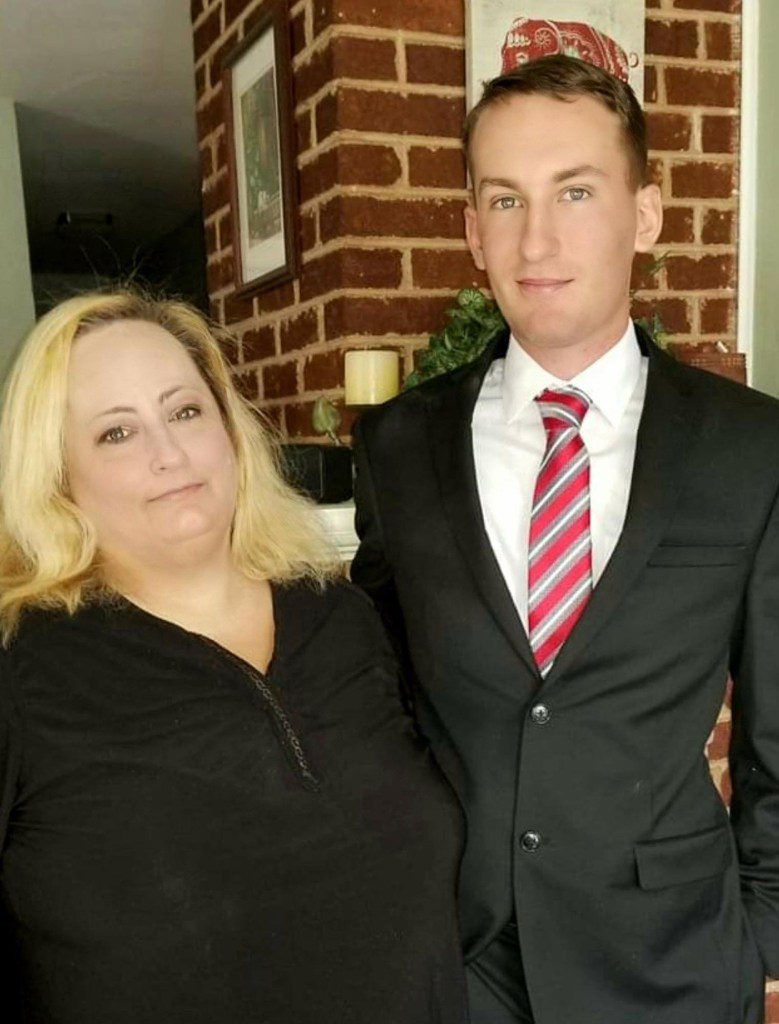
Michael Brown (with his mother, Vanessa) was the main suspect in Rodney’s murder.
Courtesy of Vanessa Hanson
Once a suspect was established, the investigation progressed rapidly. Authorities learned that Michael’s last interaction with Rodney was when he was kicked out of the house at 17, and that even before Michael deserted the Marines, he was being investigated by the Naval Criminal Investigative Service (NCIS) for stealing a skid steer, a small construction vehicle. A week after he was last seen on base, on Oct. 18, NCIS had searched the sailboat where he was believed to be living and found a note he’d signed. “Fuck this shit, society is trash and life is too,” he wrote. “I’m getting out of here and going far away to start a new life. I’m not going to prison over the skid steer I stole. By the way (no surprise) I stole the skid steer.”
Soon after, on Halloween, Michael showed up at Diane’s — in a peculiar-sounding episode, he waited in Vanessa’s closet, then once she came home (Vanessa told the FBI), said his name was Wolf, that he was a professional killer working for the “Chamber,” and that he’d have to hurt Rodney.
From Vanessa, investigators also learned the relevance of another preceding incident at Rodney’s house — nine months earlier, Rodney had returned home and discovered it ransacked. Five safes containing at least seven firearms were stolen, along with a four-wheeler and other valuables. Vanessa told the FBI Michael had broken in, then gone back to base. One of the safes contained his birth certificate, which was how he learned Rodney was not, as he’d believed, his biological father.
Authorities still had no idea where Michael was, though, and the tension surrounding the investigation mounted with each passing day. Willoughby suspected Vanessa knew more than she was sharing. “But it ain’t my place to judge,” Willoughby says. “I just find out the truth, or as close as I can get to it. The rest is up to the judicial system. Sometimes it gets it wrong, and sometimes it don’t.”
AT FIRST, WHEN A MAN had shown up in late-October 2019 to an RV park on the swampy end of Lake Marion, in Rimini, South Carolina, and asked if he could show his ID later, owner Alice Weathersbee didn’t think much of it. “We don’t have any kind of excitement down here, you know what I mean?” Weathersbee says.
She didn’t know it was Michael, who’d just deserted his base. She just knew she found him odd. He always wore a red shirt and a black tie. And every day he opened up the trailer the RV was towing, pulled out a Lincoln town car, then parked it in the trailer at night. “Like he was hiding it,” she says. “I’m beginning to think this guy is like a hitman or something,” Weathersbee told her husband.
In early November, Weathersbee’s husband and one of their sons were checking on their crawfish ponds when they came across “Dick Tracy,” as they’d taken to calling Michael, lying on the ground using a tripod to sight a rifle toward a torso-silhouette target, three holes shot through the target’s head. The next day, Michael took off in the Lincoln.
“That’s when he went up there and killed his stepfather,” Weathersbee says. “Afterward, he came back and watched movies in the campground like he’d done nothing.”
In the early hours of Nov. 12, Weathersbee says, Michael took off again, this time for good. Back in Roanoke about 48 hours later, Diane was woken up by someone banging on her house — suspecting it was her grandson, she called the cops. “911 get in here!” she said frantically. “I think Michael Brown is here!” Law enforcement soon located Michael’s beat-up RV in the parking lot of nearby St. Elizabeth’s church. One of the St. Elizabeth’s parishioners, Bobby Ballance, had noticed the RV the night before — lots of people had — during the church’s weekly potluck. The next morning, when Ballance stopped by to make sure the dinner was cleaned up, he found the parking lot crawling with law enforcement and the RV destroyed — a tactical vehicle had ripped the side straight off. “I thought, ‘What on God’s green earth?’” he says. “‘That thing’s torn all to pieces.’”
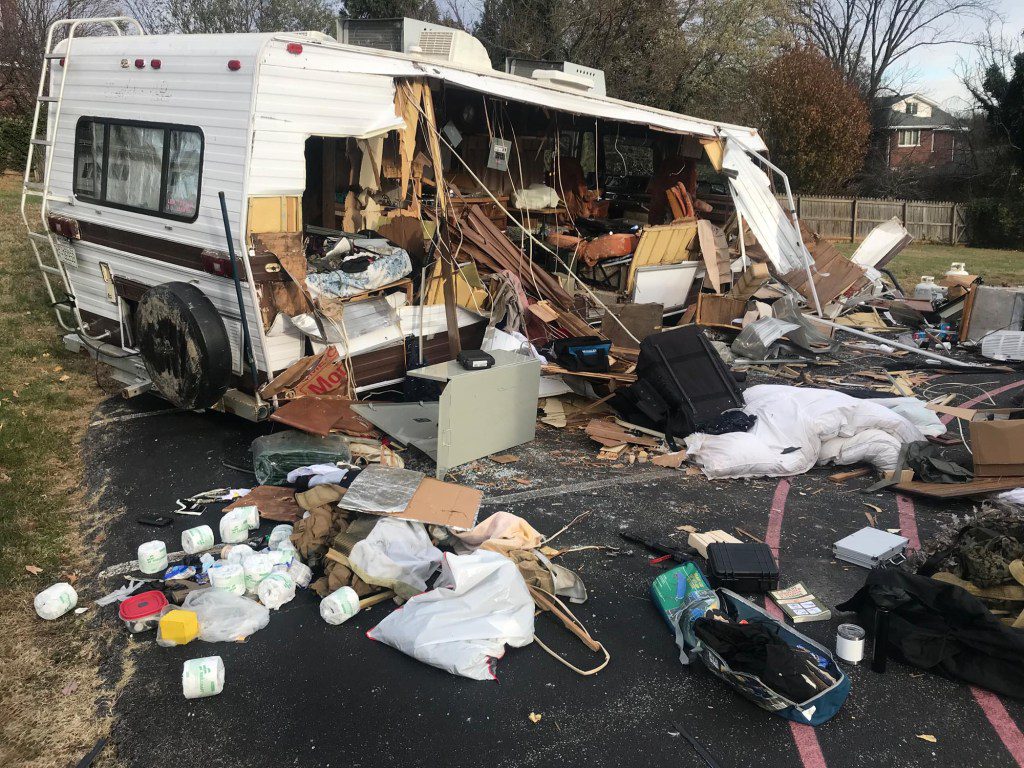
Michael Brown says he hid out in this destroyed RV as law enforcement searched it during a manhunt after he went on the run.
Authorities did not find Michael in the RV. But what they did discover put everyone even more on edge. On Michael’s laptop, there was a piece of writing that began, “I am no longer Michael Brown, he had to be killed off to make way for the darkness.” The murder, it continued, “was just part of a much larger scheme of things.” The RV also contained nine guns, including the .300-caliber blackout rifle used to shoot Rodney, ammunition, an Army handbook on explosives and demolitions, “black powder,” lock-picking tools, a chemical protective suit, and night-vision goggles.
A.J. DUDLEY IS NOW a judge, but during Michael’s manhunt, he was Franklin County’s commonwealth attorney. A tall man with a baby face, he is serious about the law, but not self-serious, with a healthy appreciation for banter.
Dudley had just won his reelection campaign and taken off on a long-promised vacation to Denver with his wife, Renee, when he got a call about the murder in Hardy. (“It’s like his spirit leaves the county and someone has to go kill somebody,” Renee says.) Later, Dudley noticed the title of the book he picked up on that trip, about a notorious 1911 Denver murder, had an odd resonance: Murder at the Brown Palace.
The setting of Rodney Brown’s home — off a gravel road running alongside a creek — is bucolic, but the property had little in common with a palace. A single-story structure, it had a wood-paneled living room and two bedrooms crammed with everything from blank CDs to camo hats. In the yard, a few storage sheds held what someone who knew Rodney called his “man toys.”
Rodney grew up there, raised by his grandmother after his mother died of yellow fever when he was a baby; numerous relatives still live nearby. (None responded to interview requests.) “It was almost like a family compound,” says a woman whose daughter knew Michael (she asked not to be named). “Which is pretty typical out here.” She remembers Michael as a bright, socially awkward child who did a lot for attention. While she gathered the boys’ home life was not optimal — “They didn’t get new Levis when the old Levis got too small,” she says — she didn’t think much of it. “Not having a mom at home,” she says, “we could explain away the little things.”
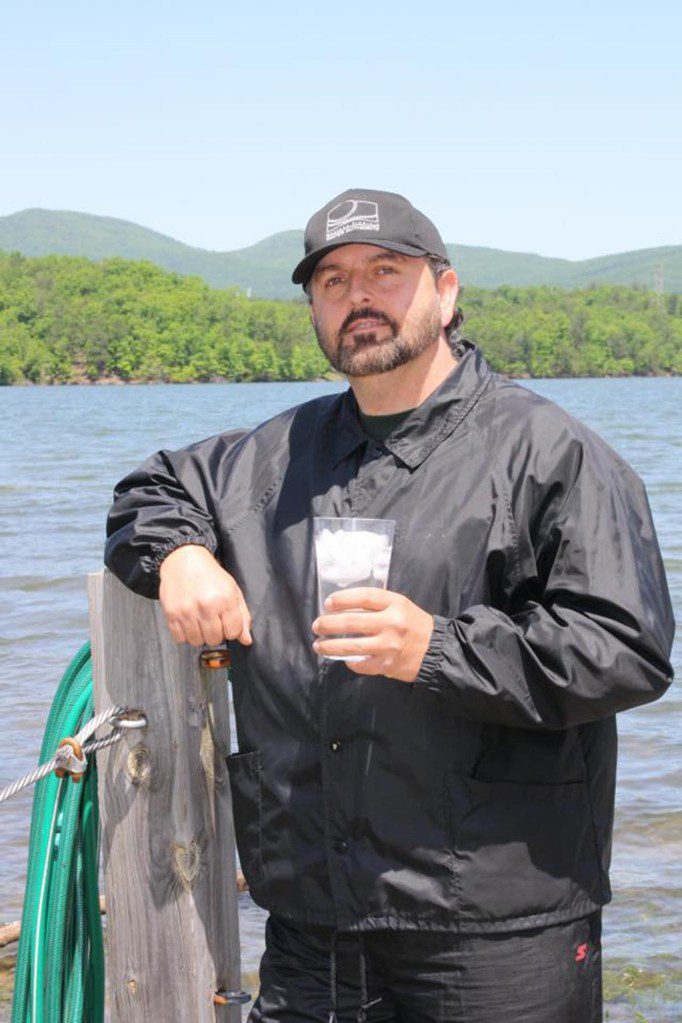
Rodney Brown helped raised Michael and was accused of abusing him.
Western Virginia Water Authority
“I admired Rodney,” says another woman who knew him, not least because he was raising Michael as his own (the woman, who also asked not to be named, thought it was common knowledge that Rodney wasn’t Michael’s birth father, though if so, the information never reached Michael). “He was quiet and he was country, but he was very responsible,” she says.
That this was how he was perceived was why, after the murder, when rumors of abuse started to emerge, some dismissed them out of hand. Then on Nov. 25, a local TV channel revealed that, per 2006 court documents, Rodney was accused of child abuse and neglect.
By then, Michael was already well on his way to becoming, for some, a local folk hero. A Facebook group called Justice for Michael Brown soon had more than 1,000 members, who discussed reports and rumors about Michael, derided news coverage they believed made him sound overly dangerous, and expressed their enthusiasm for, say, a bumper sticker reading “#RUNMICHAELRUN.”
Just before Thanksgiving, Michael’s brother, Timothy, returned home from college and found food and a blanket in a crawl space at the house. Early on Nov. 27, snipers began a stakeout. Hours later, as a state-police SWAT team searched the residence, an officer spotted legs descending from an access panel in the ceiling of Rodney’s bedroom closet. It was Michael, a small notebook in his pocket and a .22-caliber handgun tucked into his belt — if he couldn’t keep the book, he told the officer, he would kill himself. “Fine, you can keep the book,” the officer said; Michael gave up the gun. The manhunt ended exactly where it all began.
At the Franklin County Sheriff’s Office, Michael met with Willoughby and another investigator, Steve McFarling, and told them he didn’t want to talk about the events of Nov. 9. Other than that, though, he was happy to discuss just about anything at all. “How much time you got? Shit, I will tell you my whole life story,” he said. During the next four hours, between apologizing for not smelling better (“Deodorant was not a priority”) and offering tips for their next manhunt (“I’m a supporter of police”), Michael shared various formative experiences of his life. “I was thinking, ‘I’m going to meet Chris Kyle,’” Willoughby says, referring to the Navy SEAL who inspired the film American Sniper. “But it was little Michael Brown, and he was so young and so friendly.” As she left the room, she ran into Deborah Caldwell-Bono, the lawyer who’d recently agreed to represent Michael. “Your client sure is a likable guy,” she told her.
CALDWELL-BONO HAS a gravelly voice, greets just about every woman with “Hey, girl,” and drives a Jaguar with a vanity plate that reads “PRO BONO.” She and Willoughby are friends (Willoughby’s daughter-in-law is Caldwell-Bono’s hairdresser), but she first heard about Michael’s situation from Rodney’s neighbor Patsy Murphy, who’d asked for her help encouraging Michael to surrender. Caldwell-Bono assumed Michael’s apprehension would be the end of it (she’d taken on the job pro bono). “But the more I got to know him, the more I decided to see it through to the end,” she says. Much of what she learned about Michael’s past was horrifying, and some was baffling, but she came to have no doubt he was telling the truth.
When Michael was young, Vanessa was a Cub Scout leader and school volunteer. But she struggled with her own mental health and history of trauma. (After being sexually abused as a child, Vanessa was institutionalized for much of her teenage years; she has been given a number of diagnoses, including borderline personality disorder and PTSD.) When I talk to Michael on the phone last summer, he is matter-of-fact as he goes through the details of his childhood. Around five, he attacked Rodney with a butterfly net to stop him from choking Vanessa; in response, Rodney threw him across the room. Around eight, Michael and his brother went into foster care. (What prompted this is not clear — the court records are sealed, and while Vanessa remembers this occurred after she asked social services for help with the cocaine addiction she was struggling with, the leaked court documents about Rodney’s child-abuse charges suggest these are what prompted the boys to be placed in foster care. The Department of Social Services denied access to these records even to Caldwell-Bono.) As Michael told forensic psychiatrist Simopoulos in an evaluation, “My mom was doing drugs, and my stepdad was abusive. It could be any combination of things.”
Not long after that, Vanessa pleaded not guilty by reason of insanity for felony possession of cocaine — she claims her lawyer told her she’d be out in a few months. (Her files are also sealed.) In Virginia, though, as in most states, acquittees can be held as long as they are deemed mentally ill and dangerous; she was kept for eight years. “It tore my family up,” she says. “All the stuff I’d planned to do as a mom, gone.”
Rodney fought to get the boys back from foster care. Once he did, about a year later, he brought them to Vanessa for monthly visits. Per Michael’s account, the abuse also escalated. “I think my mom being in the hospital was the stress that was pushing him over the edge,” Michael says. One winter, Rodney punished the boys by locking them outside barefoot for so long that they peed on each other’s feet to stay warm. Michael estimates he lost consciousness at least 20 times from Rodney slamming his head into the wall. Timothy, who is in his early twenties, declined to speak with Caldwell-Bono (and didn’t respond to me), but showed investigators holes in the wall of his and Michael’s bedroom he said were caused by this. One was on top of a Spider-Man sticker, making for uncanny imagery — Spider-Man crouched on the wall with a hole at his center, as if a force rammed through him so violently it transmuted him from superhero into, instead, a void.
VANESSA DESCRIBES MICHAEL as an affectionate child who could be a handful, like the time he brought a lizard onto a school bus. In elementary school, he was bullied. In high school, he joined the JROTC program; his dream was to become a Marine — he was always talking about “shooting bad guys,” one friend of his, Sierra Bradley, recalls. He was also a class clown and an atheist who often wore a suit to school (“I always told him, ‘Dress to impress,’” Vanessa says). Which made him something of an outlier at Franklin County High School.
Just after his graduation, Michael was walking to his room one night when Rodney said to him, “Why the fuck are you still here?” Per Michael and Vanessa, who’d just been released from the psychiatric facility, Rodney kicked Michael through the screen door. Michael walked barefoot to Bradley’s house, but her parents called the cops, concerned about harboring a runaway (Michael was 17). Police brought him home, but he wouldn’t return inside. “I was like, ‘Fuck, hell no, I have a boot print [on my back],’” he told Willoughby and McFarling.
He spent the next several months homeless, sleeping in the janitor’s closet of a nearby town park. Eventually, he got a job as a security guard and moved in with his girlfriend. His attempts to join the Marines were stymied by his medical history (as a child he’d been diagnosed with ADHD and had Lyme disease, which went untreated so long it prompted hallucinations). In July 2016, though, Michael enlisted. After boot camp, Michael and his girlfriend married. (She gave Michael the notebook he had when apprehended, which she filled with things she loved about him.) It was “the most happy thing I’ve ever done in my life,” Michael told Simopoulos. “It was a little bit of sunshine in a pretty [bad] existence so far.”
THE CHAIN OF EVENTS that culminated with Rodney’s death began in April 2018, when Michael’s wife left him while he was deployed in Italy. He handled it, he says, largely by drinking. Not long after Michael returned stateside, Vanessa then told Michael that Rodney had put a gun to her head, asked if she was feeling lucky, and pulled the trigger. That prompted Michael to break into the house to steal Rodney’s guns. But learning that Rodney was not his biological dad, Michael says, left him relieved. “Whatever was making him like that,” he says, “I didn’t have it in me.” (Vanessa moved in with Rodney two weeks after Michael was born, at which point they decided together, she says, to raise Michael as his; she has never spoken publicly about who the father is.)
By the summer of 2019, Michael was sleeping in a box trailer in a base parking lot. “It was boiling hot,” he says. “But when you’re that depressed you don’t care.” One day, he was out target shooting when a dog started barking at him. The next thing he knew, he says, he was looking down at the dog, floating in a river, dead. “It was almost like coming out of a dream, but there was no dream,” he told Sharon Kelley, a psychiatrist at the University of Virginia who conducted a court-ordered evaluation of Michael in 2021. “And it was almost like being teleported.”
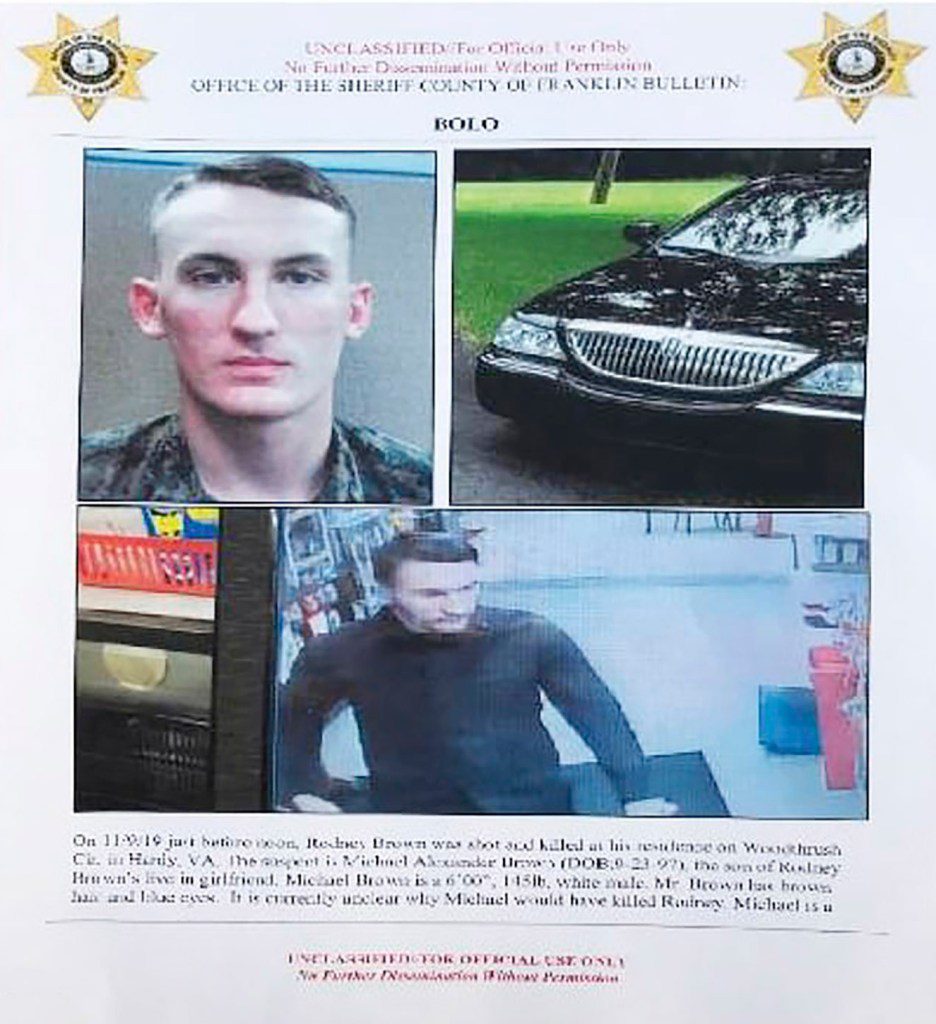
After Michael Brown went on the run, he was added to the FBI’s Most Wanted List.
Franklin County Sheriff’s Office
In the weeks that followed, he says, he had more episodes. Most often, he’d return to consciousness with a gun to his head. He considered that he was possessed. “But I’m just not that spiritual,” he says. He wondered if he had another personality. But he ultimately dismissed this too, assuming it was “a pop-culture thing.” What he knew was that they came on when he was stressed, that one of the only things that helped was reading from the book his ex-wife gave him, and that no one could know. “He was afraid he would end up in a mental hospital like his mom,” Caldwell-Bono says. He deserted because he was worried he’d hurt someone; he reportedly stole the skid steer to finance the purchase of the RV. In retrospect, he told Kelley, it would have made sense to discard his guns, but “at the time, I was so in love with them. I don’t know, it’s stupid.”
Michael returned to Roanoke on Halloween in the hopes of talking to his mom about the blackouts. But not long after he saw her, he says, he dissociated. Michael returned on Nov. 9 with the same aim. But while he remembered pulling up the driveway at Rodney’s house, he recounted to Kelley and Simopoulos that he retained only moments of what happened next. First, he was in the woods, with guns. Then he was standing above Rodney. Finally, he huddled with his mom in the bathroom, crying.
The final time he returned to Roanoke, again to try to explain his mental state to his mom, he parked at St. Elizabeth’s and briefly saw her. But as soon as Vanessa realized Diane had called the cops, she told him, “Michael, run!” He raced back to the RV. What he claims happened next is that he was inside the RV the entire time it was being searched by law enforcement, tucked in a tiny cabinet; it happened to contain his Marine Corps-issued gas mask, and after the propane tank was broken during the search, he says, he put it on.
Michael says he stayed there as it got dark, even as it was towed a few miles away. He then slipped out of the cabinet, climbed over a fence, and spent three days navigating through the woods to Rodney’s place. There, he regularly checked the news about the manhunt. He also made a fake Facebook account, joined the Justice for Michael Brown group, and posted a meme — it showed a man in a cabinet, labeled “Michael Brown,” smiling as another man in tactical gear rushed by, gun raised, oblivious.
To anyone who saw the state of the RV post-search, that Michael was in it seemed absurd. It was so destroyed that Dudley texted his wife, “All my evidence just got blown up.” But about a month later, when Willoughby, Dudley, McFarling, and Caldwell-Bono together visited the tow lot, they found the cabinet Michael referred to open, and beneath it, a gas mask. Willoughby also listened to bodycam footage on which people said the exact things Michael claimed he’d overheard. “One of the officers was like, ‘Wouldn’t it be some shit if he was in here,’” she says. “Well, he was in there, and he heard that!”
THE FRANKLIN COUNTY COURTHOUSE is a stately building with white columns and a statue of a Confederate soldier out front. This was where the preliminary hearing for Michael was held, in June 2020. During Caldwell-Bono’s cross-examination of Vanessa, she didn’t question her account of the murder. Instead, she established that the Michael that Vanessa saw the morning of the murder was “not your Michael.” She was setting the groundwork, in other words, for an insanity defense.
The idea that someone too mentally ill to differentiate right from wrong should not be held legally responsible for their actions is an ancient one, and can be found even in Rome’s sixth-century Justinian code. The logic is straightforward — how can you punish someone for something they are unable to prevent? But as psychologist and attorney Susan Vinocour points out in her book Nobody’s Child: A Tragedy, a Trial, and a History of the Insanity Defense, “Law and order demand that we convict the guilty, while justice demands that we acquit the innocent. But it is often hard to tell where justice lies when mental health and legal issues collide.”
What qualifies a person as not guilty by reason of insanity, or NGRI, has shifted dramatically over the years. Which is perhaps inevitable, considering that our understanding of mental illness has changed so much through time. Someone who today might be diagnosed with dissociative identity disorder would have previously been told they had multiple personality disorder. Before that, they would have been called schizophrenic or hysteric or, longer ago, possessed.
The legal system’s definition of insanity has also often been influenced by public opinion rather than, say, psychology. In 1981, after John Hinckley Jr. shot President Ronald Reagan (to impress Jodie Foster) and was found NGRI, the subsequent outcry prompted federal and numerous state standards to become more restrictive. Today, four states have abolished the NGRI defense altogether. But in Virginia, the law requires that a defendant establish that at the time of the crime they had a mental disease or defect that caused them to either not understand their actions’ consequences, be unable to distinguish right from wrong, or experience an “irresistible impulse.” In practice, though, “it doesn’t matter too much how you formulate an insanity defense,” Slobogin, the law professor, says. “Juries are going to go with their gut reaction.” As Michele Galietta, a forensic psychologist and professor at John Jay College of Criminal Justice, puts it: “Laws are dispassionate. But the people that apply them are human.”
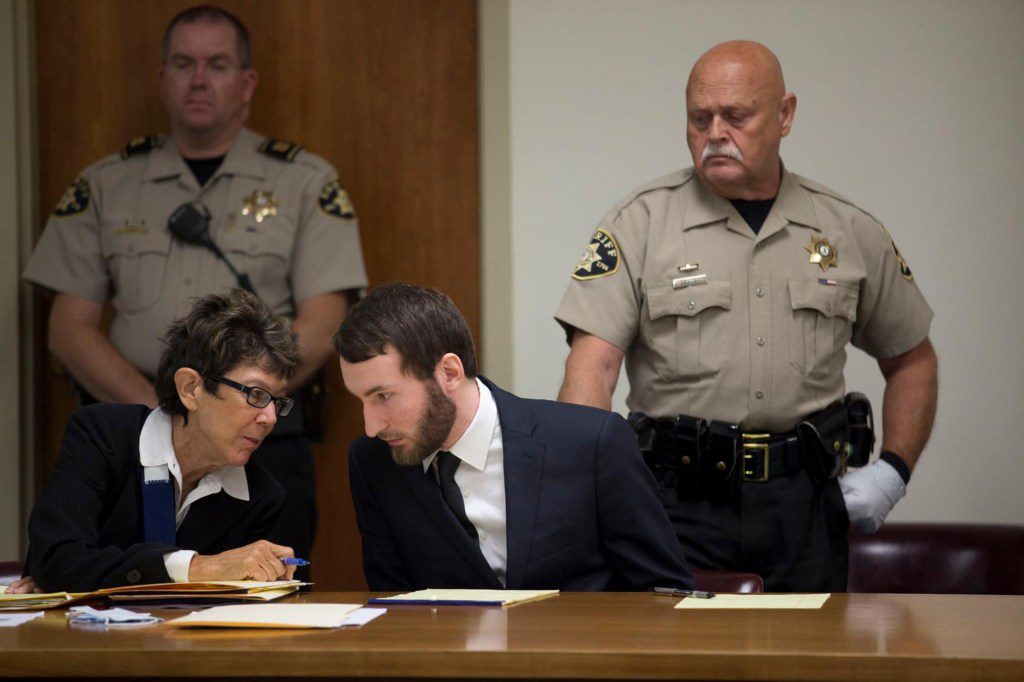
Michael Brown’s attorney, Deborah Caldwell-Bono, argued in court that her client met the criteria for an insanity plea after an evaluation showed he had symptoms consistent with dissociative amnesia.
The Roanoke Times
After Hinckley’s case, then-Sen. Dan Quayle endorsed constituents’ views that the insanity defense “pampered criminals,” allowing them to kill “with impunity.” But this is just one of many misconceptions about it. While people found NGRI are diverted from a punitive system into one meant, instead, to help them, “they tend to spend longer in a mental hospital than they would in prison for a similar crime,” Galietta says. Insanity-defense cases also so rarely go to trial (like all cases, they’re more likely to lead to a plea bargain) that Caldwell-Bono never had an NGRI case be tried in court until Michael. “In my humble opinion, it takes a likable defendant, an unsympathetic victim, and a substantiation of mental illness,” she says. (Galietta echoes this assessment — an NGRI defense is often successful when it involves “a defendant you can feel compassionate towards,” she says, “and a victim who you don’t necessarily feel sorry for.”) If this had not proven feasible with Michael, though, Caldwell-Bono considered another option. “I don’t mean to be insensitive, but there’s a saying in the criminal-defense world: There’s always the ‘He needed killing’ defense.”
THE FIRST STEP TOWARD an NGRI defense was to have Michael evaluated by a court-appointed psychiatrist, Kelley. After administering psychological tests meant to assess whether Michael was faking his symptoms (among other things), speaking with Michael for 15 hours, as well as with Vanessa and Diane, and looking over documents, Kelley determined Michael had “hints of other identities,” a hallmark of dissociative identity disorder, or DID, but that ultimately his symptoms were consistent only with dissociative amnesia. (Dissociative amnesia and DID are both understood to be caused by trauma, and can each involve gaps in memory.) As a result, she wrote in her report, he was unable to understand the consequences of his actions and met the criteria for Virginia’s insanity defense.
At that point, Dudley could have accepted Kelley’s findings. But so much of Kelley’s report rested on Michael’s own account. Michael next met with Simopoulos, the second evaluator. But while he too concluded Michael met Virginia’s insanity defense, he diagnosed him with depression, “[possibly] associated with psychosis,” he wrote in his report. Michael’s ex-wife, meanwhile, told NCIS that Michael was a psychopath with an alter ego he referred to as his “mean side.” (She didn’t respond to an interview request.)
Dudley and Caldwell-Bono agreed to a bench trial, meaning it was heard only by a judge; Simopoulos and Kelley were the only witnesses. Caldwell-Bono maintained that Michael would never have pursued an elaborate plan with the aim of ending up in a mental hospital, a place he never wanted to be. (“If Michael had planned the murder, he would have done it better,” she said during the trial. “He would not have done it in front of his mother.”) “But it was an alternate explanation!” Dudley says. “So I felt like there was an argument to be made on behalf of the government.”
During closing statements, Dudley, carrying the .300-caliber blackout rifle Michael used during the murder, argued that Kelley’s report was “a house of straw.” Caldwell-Bono laid out a defense that suggested a fantastical arc, in which trauma caused a boy to create an alter ego that returned, years later, to destroy the source of his trauma. And on Feb. 23, 2022, the judge sided with Caldwell-Bono. All of this was “hard to understand or accept,” the judge declared, but she believed it unlikely Michael could have fabricated all the necessary evidence to support Simopoulos’ and Kelley’s findings. “So for those reasons,” she said, “the court will find Michael Brown not guilty by reason of insanity.”
FOR MORE THAN A YEAR now, Michael has resided at a mental hospital in Danville, Virginia. In our conversations, he is by turns earnest, introspective, and self-deprecating, with no apparent inclination toward self-pity. He often seems as baffled by the recent turns of his life as anyone else. “I’m not 100 percent sure what she meant by that,” Michael says about his ex-wife calling him a psychopath. “If I could get clarification from her or somebody that would have been great.”
He still dresses neatly — when Murphy, his former neighbor, visited him recently, he’d spit-shined his shoes with jelly. He goes to treatment groups three times daily, and after dinner attends “evening leisure.” The night before we talk, he sang “Take Me Home, Country Roads” at karaoke. “Singing isn’t a passion of mine,” he tells me. “But I like to be fun, so I participate.” While Michael is willing to answer just about any question I have about his past, he is far more eager to discuss his appreciation for Caldwell-Bono and his determination to “make my future not shitty.”
Michael hasn’t had an episode of “lost time” in almost four years, he says, but so far, when he’s been evaluated for release, the recommendation has been that he remain in the psychiatric facility. He hopes to one day live on a sailboat and to start a sailing academy. “You can be free and not have to worry about common problems,” he says. “All you have to worry about is where the wind is coming from.”
What I heard from a lot of people familiar with Michael’s situation is that they don’t know enough about dissociative amnesia to have an opinion about it, but they are glad the trial resolved how it did. “I don’t know about any kind of personality disorder he may or may not have had,” says Yolanda, Ballance’s wife. “But he had a rough childhood, it seems. And if anything’s justifiable …” The woman whose daughter knew Michael says her guilt colors everything else. “I hate myself for not being aware enough to change what, in my mind, was that poor child’s life,” she says. “I feel sorry for Michael.”
Rodney never had a funeral, though there was a viewing at a funeral home. “I insisted on that,” Vanessa says. “I wanted to say goodbye.” His ashes now sit in her closet. What had Rodney’s childhood been like? Years ago, when Murphy learned Michael was homeless, she’d driven to the reserve where Rodney worked to try to better understand him. “All this bad stuff was happening, and I thought, ‘I wonder why?’” she says. When she arrived, though, the place was as she remembered — quiet and peaceful.
When I visit last spring, there are kayaks pulled up on the reservoir’s beach, and butterflies in the reeds. A few older guys play oldies from a battery-powered radio. No one wants to give their name, or talk about Rodney. But one admits knowing him. “He was just like the rest of us,” he says. “A regular guy.”





